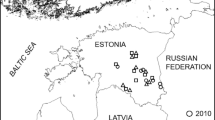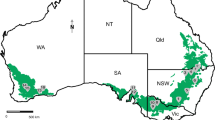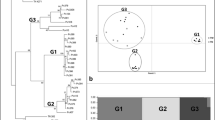Abstract
Gibberella pulicaris is the sexual stage ofFusarium sambucinum, the major cause of potato tuber dry rot in North America and Europe. In a previous study 42 strains from dry-rotted tubers in North America were analyzed for genetic diversity by mating type and vegetative compatibility group (VCG) tests. In the present study, an additional 96 strains from North America, 21 strains from Europe, and six strains from other geographic areas were analyzed. Both mating types, MAT1-1 and MAT1-2, occur widely outside North America. In contrast, all but two, Canadian, strains of the 138 North American strains analyzed to date are MAT1-1. VCG analysis provides additional evidence that genetic diversity ofG. pulicaris from potato tubers is high in Europe but low in the United States. These results suggest that the potential for pathogen change due to sexual recombination is low in the United States, but may be higher in Europe. Limited genetic diversity ofG. pulicaris in the United States indicates that there are likely to be few barriers to heterokaryon formation and asexual recombination in the field. Thus, the potential exists for rapid spread and persistence of advantageous mutations throughout theG. pulicaris population, which may have contributed to the recent proliferation of strains resistant to the fungicide thiabendazole which has been widely used to control tuber dry rot.
Compendio
Gibberellapulicaris es el estado perfecto o sexual deFusarium sambucinum, el agente principal de la pudrición seca de los tubérculos de papa en Norteamérica y Europa. En un estudio anterior, se analizaron 42 variantes obtenidas de tubérculos con pudrición seca en Norteamérica, en pruebas para diversidad genética por tipo de apareamiento y grupo de compatibilidad vegetativa (GCV). En este estudio, se analizaron 96 variantes adicionales de Norteamérica, 21 de Europa y seis de otras zonas geográficas. Ambos tipos de apareamiento, MAT1-1 y MAT1-2, se presentaron extensivamente fuera de Norteamérica. Por el contrario, todas excepto dos variantes canadienses, de las 138 variantes norteamericanas analizadas hasta la fecha son MAT1-1. El análisis de GCV provee evidencia adicional de que la diversidad genética deG. pulicaris de tubérculos de papa es alta en Europa, pero baja en los Estados Unidos. Estos resultados sugieren que el potencial de cambio del patógeno debido a la recombinación sexual es baja en los Estados Unidos, pero puede ser más alta en Europa. La diversidad genética limitada deG. pulicaris en los Estados Unidos indica que podrían existir en el campo algunas barreras a la formación de heterocariones y a la recombinación asexual. Por lo tanto, existe potencial para una rápida diseminación y persistencia de mutaciones ventajosas en toda la población deG. pulicaris, lo que puede haber contribuido a la reciente proliferación de variantes resistentes al fungicida thiabendazole que ha sido ampliamente utilizado en el control de la pudrición seca del tubérculo.
Similar content being viewed by others
Literature Cited
Boyd, A.E.W. 1972. Potato storage diseases. Rev Plant Pathol 51:297–321.
Correll, J.C., C.J.R. Klittich and J.F. Leslie. 1987. Nitrate nonutilizing mutants ofFusarium oxysporum and their use in vegetative compatibility studies. Phytopathology 77:1640–1646.
Desjardins, A.E., E.A. Christ-Harned, S.P. McCormick and G.A. Secor. 1993. Population structure and genetic analysis of field resistance to thiabendazole inGibberella pulicaris from potato tubers. Phytopathology 83:164–170.
Gordon, W.L. 1954. Geographical distribution of mating types inGibberella cyanogena (Desm.) Sacc. Nature (London) 173:505–506.
Hide, G.A., P.J. Read and S.M. Hall. 1992. Resistance to thiabendazole inFusarium species isolated from potato tubers affected by dry rot. Plant Pathol 41:745–748.
Kawchuk, L.M., J.D. Holley, D.R. Lynch and R.M. Clear. 1994. Resistance to thiabendazole and thiophanate-methyl in Canadian isolates ofFusarium sambucinum andHelmithosparium solani. Am Potato J 71:185–192.
Langerfeld, E. 1986. Thiabendazol-resistenz beiFusarium sulphureum. Pflanzenschutz-Nachr. (Braunschweig) 38:165–168.
Leach, S.S. 1985. Contamination of soil and transmission of seed borne potato dry rot fungi (Fusarium spp.) to progeny tubers. Am PotatoJ 62:129–136.
Leslie, J.F. 1993. Fungal vegetative compatibility.In: Cook, R.J., G.A. Zentmyer, and G. Shaner (eds.), Annual Review of Phytopathology. Annual Reviews Inc., Palo Alto, CA. pp. 127–150.
Secor, G.A., D. Rodriguez, J. Rodriguez and N.C. Gudmestad. 1994. Distribution and incidence of benzimidazole-resistantFusarium sambucinum andHelminthosporium solani isolated from potato in North America.In: Heaney, S., D. Slawson, D.W. Hollomon, M. Smith, P.E. Russell and D.W. Parry (eds.), Fungicide Resistance. British Crop Protection Council Monograph No. 60. Farnham, Surrey, U.K. pp. 271–279.
Tivoli, B., A. Deltour, D. Moley, P. Bedin and B. Jouan. 1986. Mise en evidence de souches deFusarium roseum var.sambucinum resistantes au thiabendazole, isoles a partir de tubercules de pomme de terre. Agronomie 6:219–224.
Author information
Authors and Affiliations
Rights and permissions
About this article
Cite this article
Desjardins, A.E. Population structure ofGibberella pulicaris (AnamorphFusarium sambucinum) from potato tuber dry rot in North America and Europe. American Potato Journal 72, 145–156 (1995). https://doi.org/10.1007/BF02849350
Accepted:
Issue Date:
DOI: https://doi.org/10.1007/BF02849350




